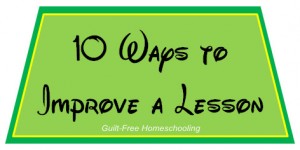Sometimes we all need help teaching a lesson. The lesson may be too confusing, too short, or just plain boring. Your student may need a more complete explanation or just want to delve more deeply into the subject. You may need to expand the lesson to include an activity to fit your student’s learning style. No matter what the reason, here are a few suggestions for how to improve a lesson.
- Make it bigger. — Suppose your child is learning fractions, and the book’s diagrams are rather small. Draw similar diagrams using an entire sheet of paper for each one — sometimes bigger IS better! Simple drawings and diagrams do not demand precision: children are good at pretending, and they can pretend along with you that your drawing is accurate.
- Take it outside. — Fresh air and elbow room can improve anyone’s ability to think. Even reading a favorite storybook outdoors can give it new perspective.
- Add color. — Say good-bye to black-and-white; say hello to understanding. Use colored pencils or markers, highlighters, construction paper, or colored index cards. For example, write each step of a complicated math problem in a different color to help clarify the progression.
- Add texture. — Go beyond flat and give your fingertips a chance to enjoy themselves. Form ABC’s with Play-Doh, cut letters out of sandpaper, or draw with chalk on the sidewalk.
- Let your student play with it. — Exploration is the birthplace of genius. Go beyond the lesson plan and indulge your student with his own session of free experimentation, whether with math manipulatives, Scrabble letter tiles, vinegar and baking soda, etc. Playing is learning.
- Add more details. — Why strain to understand a single example, when ten examples will make it crystal clear? Suppose your child is trying to learn the letter A; show the child many examples of what A looks like, from several ABC books, from newspaper headlines, on packages in your pantry; draw A with crayons and markers, in shaving cream smeared on a window, in dry cornmeal poured in a baking pan; arrange small items into an A shape: pennies, pipe cleaners, pencils, building blocks, toy cars, fingers, etc. — after all of these examples, your child will better understand how to recognize an A!
- Discuss it. — Skip the one-sided lecture and the interrogation-style Q & A session; try an open and honest give-and-take, valuing your student’s opinions, reactions, and ideas. How would you react if those opinions were coming from your friend, instead of from your child?
- Build it. — Cardboard, scissors, and tape are the stuff that feeds imagination. Projects don’t have to be constructed well enough to last forever, just long enough to illustrate the concept.
- Research it (together). — Expand two great minds at the same time. The teacher doesn’t always have to know the answers before the student does — your student will develop new respect for you as he sees you willing to learn with him.
- Make it personal. — Use a personal application to your student’s own life, activities, or possessions, and he’ll never forget it. Instead of math manipulatives, use the student’s building blocks, toy cars, baseball cards, Barbie doll shoes, etc.
The specific examples given above might be either too simple or too advanced for your current needs, but you can adapt them to your student’s situation. Even if you think some of these ideas may not help with your particular struggles, dare to give them a try anyway. You may be pleasantly surprised at the results!



 Guilt-Free Homeschooling is the creation of Carolyn Morrison and her daughter, Jennifer Leonhard. After serious disappointments with public school, Carolyn spent the next 11 years homeschooling her two children, from elementary to high school graduation and college admission. Refusing to force new homeschooling families to re-invent the wheel, Carolyn and Jennifer now share their encouragement, support, tips, and tricks, filling their blog with "all the answers we were looking for as a new-to-homeschooling family" and making this website a valuable resource for parents, not just a daily journal. Guilt-Free Homeschooling -- Equipping Parents for Homeschooling Success!
Guilt-Free Homeschooling is the creation of Carolyn Morrison and her daughter, Jennifer Leonhard. After serious disappointments with public school, Carolyn spent the next 11 years homeschooling her two children, from elementary to high school graduation and college admission. Refusing to force new homeschooling families to re-invent the wheel, Carolyn and Jennifer now share their encouragement, support, tips, and tricks, filling their blog with "all the answers we were looking for as a new-to-homeschooling family" and making this website a valuable resource for parents, not just a daily journal. Guilt-Free Homeschooling -- Equipping Parents for Homeschooling Success!

I wish I had found your website 3 years ago when I first started homeschooling. It is so hard to find homeschool websites that have advice for those in Jr. and High School years. Thank you.